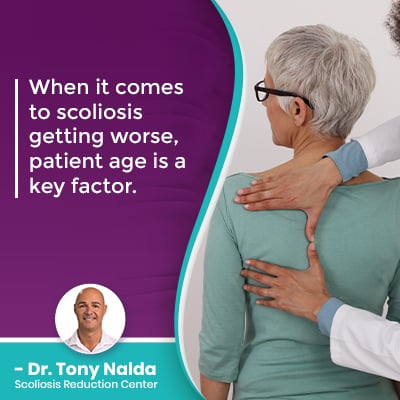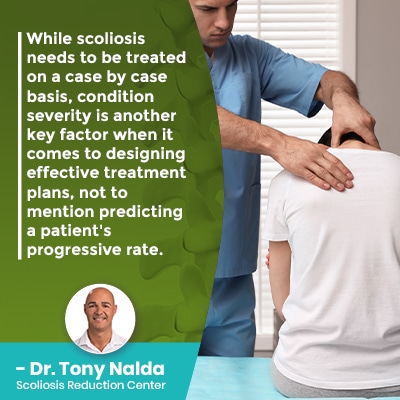Learn What Causes Scoliosis To Worsen [ANSWERS]
![Learn What Causes Scoliosis To Worsen [ANSWERS]](https://drtonynalda.com/wp-content/uploads/2023/05/Learn-What-Causes-Scoliosis-To-Worsen-ANSWERS.jpg)
It's important that patients fully understand the progressive nature of scoliosis, and the role that treatment can play in managing progression. While there are different types of scoliosis, determined by various causes, all forms of scoliosis are subject to progression.
As a progressive condition, scoliosis is virtually guaranteed to worsen at some point, and while we don't always know what triggers the condition's initial onset, we do know how to treat it, and we do know what triggers its progression: growth and development.
As there are many variables that factor into how bad a person's scoliosis can get, let's start with how the condition is diagnosed, classified, and the factors that most directly affect progression.
Table of Contents
Diagnosing and Classifying Scoliosis
Before getting to the specifics of how different patient factors influence rates of progression, I want to clearly explain what scoliosis getting worse actually means.
Scoliosis getting worse is its nature, as a progressive condition, and scoliosis progressing means the unnatural spinal curve is increasing in size, and as this occurs, the condition's uneven forces are increasing more and more, as are their effects.
The worse scoliosis gets, the larger the curve is, and the more difficult it is to treat, hence the benefit of early detection and intervention.
When scoliosis is first diagnosed, part of the process involves further classifying conditions based on important patient and condition variables.
These variables help streamline the treatment process and shape the design of effective treatment plans.
Patient age, curvature location, condition severity and type are important factors that vary from person to person.
Let's talk about which of these variables most directly affect a patient's rate of progression.
Patient Age
Patient age is a significant factor in many ways, but in terms of how a patient is going to experience life with scoliosis, pain and progression are greatly impacted.
While scoliosis is more prevalent in children, it does also affect adults, and scoliosis doesn't become compressive until adulthood.
Scoliosis is the development of an unnatural spinal curve that bends unnaturally to the side, but also rotates, making it a 3-dimensional condition.
While it can seem hard to imagine that an unnatural spinal curve wouldn't be overly painful and could actually go unnoticed for many years, this is quite common.
Scoliosis Pain
The main cause of condition-related pain is compression (uneven pressure) of the spine and its surrounding muscles and nerves.
So in children who are still growing, their spines are undergoing a constant lengthening motion, and this counteracts the compressive force of the scoliotic curve, but in older patients who have reached skeletal maturity, pain is the condition's main symptom.
Age and Rate of Progression
 When it comes to scoliosis getting worse, patient age is a key factor.
When it comes to scoliosis getting worse, patient age is a key factor.
As we don't always understand what triggers the initial onset of idiopathic scoliosis (no known cause), the condition getting worse is triggered by growth.
So while all types of scoliosis are progressive, patient age significantly factors into a patient's potential progressive rate.
Patients who have not yet reached skeletal maturity, still having significant growth yet to go through, are at risk for rapid-phase progression, and this is especially the case in the most common type of scoliosis: adolescent idiopathic scoliosis.
Patients going through puberty are subject to rapid and unpredictable growth spurts, which just so happens to be the number one trigger for progression.
In addition to patient age, condition severity plays a significant role in how slowly, or quickly, a patient's scoliosis gets worse.
Condition Severity
 While scoliosis needs to be treated on a case by case basis, condition severity is another key factor when it comes to designing effective treatment plans, not to mention predicting a patient's progressive rate.
While scoliosis needs to be treated on a case by case basis, condition severity is another key factor when it comes to designing effective treatment plans, not to mention predicting a patient's progressive rate.
When scoliosis is being diagnosed, assessed, and treated, this involves a comprehensive physical examination, taking the patient's family history, careful monitoring for progression, and determining each patient's severity level.
A measurement known as Cobb angle classifies conditions in terms of severity and is determined through x ray images that reveal how tilted the vertebrae are at the curve's apex; this tells me how far out of alignment the spine is, and how severe a condition is:
- Mild scoliosis: Cobb angle measurement of between 10 and 25 degrees
- Moderate scoliosis: Cobb angle measurement of between 25 and 40 degrees
- Severe scoliosis: Cobb angle measurement of 40+ degrees
- Very-severe scoliosis: Cobb angle measurement of 80+ degrees
The more severe scoliosis is, the more it's likely to continue progressing, and this is why being proactive is so important.
A patient receiving a diagnosis of mild scoliosis isn't necessarily going to stay there; only proactive treatment can work towards counteracting the progressive nature of scoliosis.
In a healthy spine, its vertebrae are aligned and stacked on top of one another in a straight and neutral alignment, but the further out of alignment the spine becomes, the harder it is to maintain its natural and healthy curves: adverse spinal tension is increasing.
In addition, the more severe a condition, the more it affects the spine's surroundings, which includes the muscles surrounding the spine as they play a role in supporting its natural curves and alignment.
The larger a scoliotic curve is, the harder those supportive muscles have to work, and the more likely they are to become strained, weak, unbalanced, and less able to support and stabilize the spine.
As mentioned, there are also different types of scoliosis, some known to progress faster than others.
Different Types of Scoliosis
When it comes to progression, scoliosis treatment is also shaped around condition type, and different condition types are determined by causation.
As mentioned earlier, in the condition's most prevalent form, adolescent idiopathic scoliosis, diagnosed between the ages of 10 and 18, this age group is at risk for rapid-phase progression because of the stage of puberty.
In this form, to actively treat scoliosis, monitoring how the spine responds to growth is as important as observing how it responds to treatment.
Idiopathic Scoliosis
Now, idiopathic scoliosis isn't associated with a single-known cause, but we know how to treat it, and idiopathic scoliosis accounts for approximately 80 percent of known cases of scoliosis, with the remaining 20 percent consisting of types associated with known causes: neuromuscular scoliosis, degenerative scoliosis, and congenital scoliosis.
As discussed, adolescent idiopathic scoliosis patients tend to progress faster because of the stage of growth they are in.
Neuromuscular Scoliosis
Neuromuscular conditions cause the development of neuromuscular scoliosis, which tend to be particularly severe cases.
Neuromuscular conditions cause a disconnect between the brain and the muscles and ligaments that support the spine, causing the development of an unnatural spinal curve that's even more likely to progress because of the underlying neuromuscular condition, like cerebral palsy or muscular dystrophy.
Neuromuscular scoliosis cases can get worse quickly, with some patients becoming wheelchair-bound and unable to walk on their own.
Degenerative Scoliosis
Cases of degenerative scoliosis involve adults over the age of 40 who are experiencing natural age-related spinal degeneration.
As degenerative scoliosis patients are adults who have reached skeletal maturity, the trigger of growth has been removed, so this type isn't associated with rapid progression; however, these patients have spines that are degenerating, with its individual parts deteriorating, and the more deterioration that occurs over time, the worse it's going to make the scoliosis.
Now, on the opposite end of the spectrum, we have congenital scoliosis affecting babies.
Congenital Scoliosis
Babies are born with congenital scoliosis as it's caused by spinal malformations that develop in utero.
In these cases, it's difficult to predict how much worse they can get, with many cases not being diagnosed until growth has made the condition more obvious.
While babies have a lot of growth ahead of them, it doesn't occur as rapidly as adolescents going through puberty, so while cases can indeed get worse, especially if left untreated, treatment focuses more on monitoring for progression, rather than actively working towards counteracting it.
Conclusion
In order to prevent scoliosis from getting worse, a proactive treatment plan needs to be crafted around key patient and condition variables.
While the location of the curvature can play a role in progression, the factors that more directly affect how much worse scoliosis gets, and at what speed, are patient age, condition severity and type.
There are multiple factors that shape a patient's experience of life with scoliosis, and the most important is the type of treatment chosen; there are two main scoliosis treatment approaches: a traditional approach and a conservative approach.
A conservative approach focuses on preventing scoliosis from getting worse, while traditional treatment doesn't have a strategy for preventing progression, only responding to it surgically once it becomes severe; spinal fusion surgery is an invasive procedure, and most cases of scoliosis can be treated non-surgically.
Conservative treatment focuses on helping the spine to function properly by impacting conditions on a structural level through condition-specific chiropractic adjustments, physical therapy, scoliosis specific exercises, corrective bracing, and rehabilitation.
Here at the Scoliosis Reduction Center, I work towards restoring as much of the patient's healthy spinal curves as possible because it's the natural spine curves that make it stronger, more flexible, and better able to deal with mechanical stress incurred during activity.
While there are no treatment guarantees, treating scoliosis proactively has proven results that help many patients improve quality of life and continue to thrive, despite being diagnosed with a progressive structural spinal condition.
Dr. Tony Nalda
DOCTOR OF CHIROPRACTIC
After receiving an undergraduate degree in psychology and his Doctorate of Chiropractic from Life University, Dr. Nalda settled in Celebration, Florida and proceeded to build one of Central Florida’s most successful chiropractic clinics.
His experience with patients suffering from scoliosis, and the confusion and frustration they faced, led him to seek a specialty in scoliosis care. In 2006 he completed his Intensive Care Certification from CLEAR Institute, a leading scoliosis educational and certification center.
About Dr. Tony Nalda
 Ready to explore scoliosis treatment? Contact Us Now
Ready to explore scoliosis treatment? Contact Us Now





